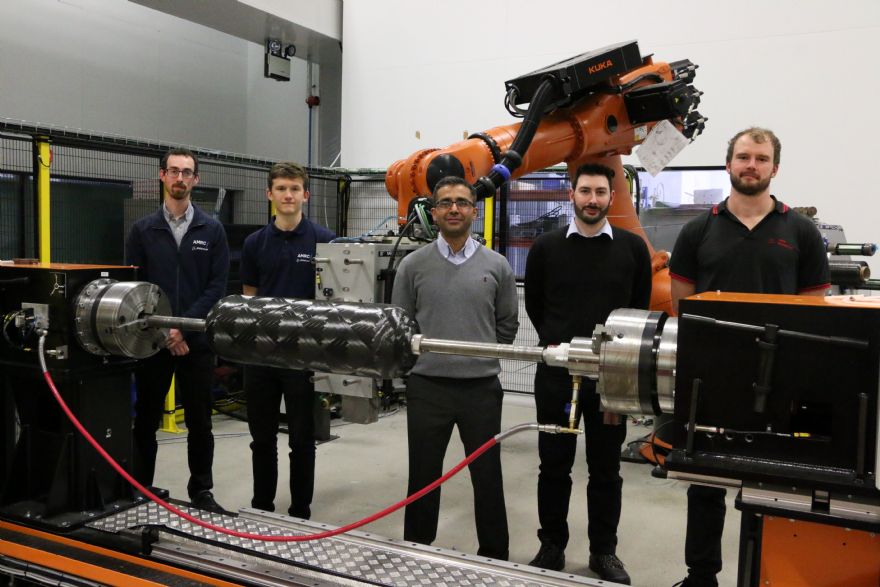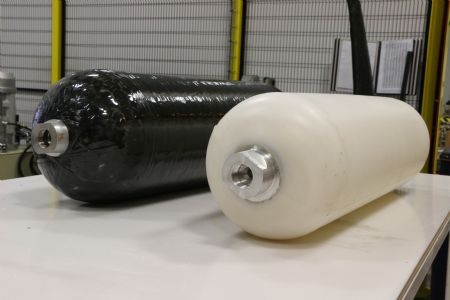
A composite hydrogen storage tank has been developed for use in the heavy duty transport sector, supporting supply chains to build their manufacturing capability and to help accelerate the decarbonisation of road transport.
Composites experts from the
University of Sheffield Advanced Manufacturing Research Centre (AMRC) worked on the project alongside two SME manufacturers on the 12-month project
Crossfield Excalibur Ltd, a specialist in tooling design for rotationally-moulded parts, and
Elite Ground Support Services, which provides rotational, extrusion and compression mouldings for the automotive sector.
Together, they designed, manufactured and tested a Type 4 cylindrical hydrogen pressure vessel, made from filament wound carbon-fibre over a thermoplastic liner. The tank has been designed for use in the automotive sector and has the capacity to hold 40-litres of hydrogen at a 350-bar pressure, with the testing being performed in line with EU regulations.
The AMRC, part of the national network of High Value Manufacturing (HVM) Catapult research centres, is at the forefront of hydrogen tank prototyping, says Zeeshan Qureshi, lead research engineer at the AMRC Composite Centre.
He said: “Using ‘state of the art’ machines, cost-effective processes and working closely with our two chosen SMEs, we are on a mission to help accelerate the UK hydrogen storage supply chain and enable rapid production of hydrogen pressure vessels through automated design, manufacture and validation to meet ‘net zero’ targets and to help push forward the decarbonisation of road transport nationwide.
“The project has also given us the chance to manufacture hydrogen pressure vessels using a filament winding machine, a process that has not been explored much within the UK. It has been a fantastic opportunity to be part of such a project and we’re excited to push our research and testing further in the next project we have lined up.”

Stuart Dawson, chief engineer for hydrogen at the AMRC, said: “Heavy long-haul vehicles are one of the most challenging segments of the road transport sector to reduce emissions due to their long journey distances and heavy payload requirements.”
He added: “For the operational economics to stack up, HGVs need long range and fast refuelling. The high weight of batteries would reduce the vehicle’s potential payload & range and would require long recharging times. So for heavy duty, long range transport applications, hydrogen fuelled vehicles - whether they are powered via fuel cells or combustion - are the ideal solution.
“Conventional metallic hydrogen storage tanks are heavy and would reduce the vehicle's payload. What is needed for transport applications is safe, affordable and lightweight hydrogen storage tanks. However, despite the high projected future demand for such tanks, there is virtually no UK manufacturing capability for composite pressure vessels.
“This project seeks to address this issue through the development of globally competitive methods of manufacture for lightweight, Type 4 hydrogen storage tanks that could eventually be deployed into UK industry.”
As a direct result of the AMRC struggling to find suitable suppliers, the collaborative project has successfully created a secure UK supply chain for thermoplastic liners for the country’s automotive original equipment manufacturers (OEMs).
Steve Davies, Crossfield Excalibur managing director, said: “This project has given us the chance to deploy our experience in rotomoulding product design and toolmaking over a span of 25 years. Along with the wider team, we have designed and developed a rotomoulding insert, capable of moulding and using a high flow polyamide polymer which withstands significant pressures.
“We have thoroughly enjoyed working with both teams at the AMRC and Elite to bring this project to life and look forward to assisting with the next phase of development.”
Kris Heard, managing director for Elite GSS, said the opportunity to work alongside the AMRC and Crossfield Excalibur to develop the project had ‘pushed boundaries’ for the company in many areas.
He said: “Not only are we pleased to be developing a new and innovative product for the UK market, but we’re also testing and stretching our manufacturing abilities further than ever before.”
He continued: “As a project it also fits in with some of our key objectives; as a business, we strive to manufacture and distribute new and revolutionary technology whilst also having a key focus on the environment and reducing our carbon footprint.”
Investment into the creation of these pressure vessels follows the launch of the Government’s ‘net zero’ and hydrogen strategies and is aimed at supporting the UK to reach net zero emissions by 2050.
The project was funded by the HVM Catapult. The next steps are to continue optimising the designs and the manufacturing process of the pressure vessels, develop testing capabilities further and to increase its storage capacity.